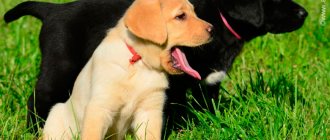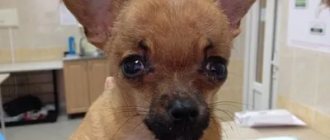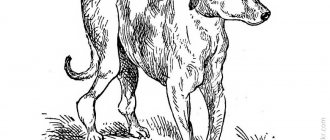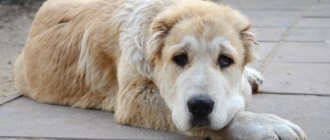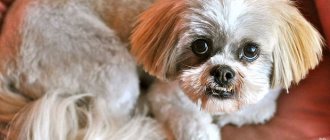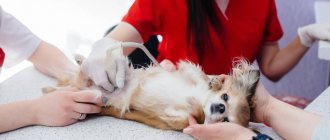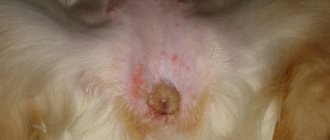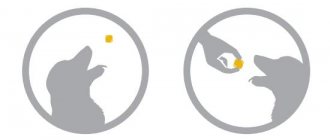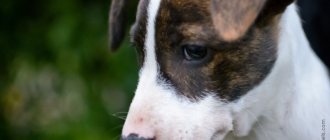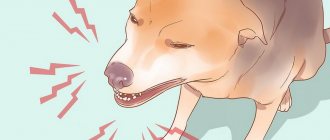Lupoid onychodystrophy in dogs. Until recently, I had never even heard such words. But, if you are a dog lover, from time to time “surprises” may await you in the form of a cut paw, an eaten chicken bone, piroplasmosis or other, not very happy surprises.
This is not a very common disease, mainly affecting the limbs and claws of the animal. And it wouldn’t be bad if every dog breeder had at least a little information about this disease.
At the initial stage, the symptoms of the disease are such that they can be easily confused with a claw injury.
And, if the correct diagnosis is not made in time, the treatment will be much more difficult and longer. I'll start in order.
Why is it important to regularly look after your dog's nails?
If you don't regularly take care of your dog's claws, they can cause many problems:
- Dogs' nails should wear down naturally. If the dog is taken out for a walk 2 or 3 times a day, the nails will not wear down. That’s why they need to be trimmed regularly. Overgrown claw plates will (at best) cause a lot of inconvenience to your pet.
- Overgrown claws often break off and split. The damaged areas are quickly colonized by pathogenic and conditionally pathogenic microflora, and severe inflammation develops. The dog cannot step on its paw due to severe pain, and if nothing is done, it can end in amputation of the fingers.
- Long claws make it very difficult to move and play normally. The dog becomes inactive, apathetic, and gains weight, which also has a detrimental effect on his health.
- The claws may grow directly into the paw pads. This leads to severe inflammation and may result in surgery.
- Sometimes the claws become affected by fungal infections. Among them there are dangerous ones for humans (microsporia, trichophytosis). If the owner does not regularly examine the pet’s paws, he may well become infected himself.
Ingrown claw
One of the most common pathologies is an ingrown claw. This problem is common among dogs living in large cities. The reason is simple - there are not enough walks, the claws do not naturally wear down, and breeders forget to trim them on time.
Symptoms
The pathology is characterized by the following symptoms:
- It all starts with lameness. At first the dog limps slightly, but after a while the animal cannot lean on its paw at all.
- The pet often sits, squealing slightly, licking or “gnawing” its paw.
- Upon examination, you can find a claw (claws), which, having bent, dug in and begins to literally grow into the pad of the paw or even into the interdigital space.
- When microflora gets into the wound canal (and this will happen after the first walk), inflammation will develop. In severe cases, the dog leaves behind prints stained with purulent or other types of exudate.
Treatment
- First, they cut off the overgrown claw and carry out an “audit” of the rest, if necessary, also shortening and trimming them.
- The inflamed areas are washed with 3% hydrogen peroxide and treated with antiseptic agents (even regular iodine or medical alcohol will do).
- If necessary, it is necessary to excise and remove dead tissue.
- For the first three days, walk the pet for 10-15 minutes so that the treated limb does not overexert itself. For a week after the procedure, you must wear special shoes on the dog’s paws before walking or protect the healing area with a bandage.
Causes of skin diseases
Animal skin diseases in veterinary medicine (dermatitis) are one of the most common pathologies. This is due to the fact that problems with the animal’s fur and skin are easy to notice with the naked eye.
The reason may be various factors:
- poor nutrition;
- stress;
- adverse reactions to medications;
- allergies to food, chemicals;
- a bowl made of low-quality, toxic plastic;
- worms, fleas, ticks;
- contact with a sick animal;
- fungi;
- skin trauma, especially wounds accompanied by inflammation;
- chronic diseases of internal organs.
Panaritium (inflammation of the claw bed)
Typically, the nail bed is reliably protected from environmental factors by a layer of fairly dense, tough skin.
But in cases of injury or chemical burns from road reagents, this protective shell is destroyed. This leads to the rapid development of inflammation under the influence of bacterial or fungal (which is much more dangerous) microflora and panaritium occurs.
Symptoms
- As in the previous case, the dog whines, constantly licks or chews its paws, and the animal limps heavily when walking.
- With panaritium, the inflammatory process is very often caused by pyogenic or fungal microflora. Because of this, the bases of the claws become very fester, and the paws smell very unpleasant.
- The skin around the base of the claws turns red, swells, and the local temperature rises noticeably.
Treatment
- First, the nail bed is washed with the same 3% hydrogen peroxide and cauterized with alcohol tincture of iodine or medical alcohol.
- The paw is washed daily with a solution of Epsom salts, but if this is not available, a saturated solution of regular table salt will do. This helps to retract exudate, relieve inflammation and swelling of tissues.
- For severe inflammation, antibiotics may be used.
- During treatment, walk with the animal for no more than 15-20 minutes; it is advisable to wear protective shoes or special shoe covers on the dog’s paws.
"Wolf's Claw"
Note that the so-called “wolf’s claw” is not a disease in itself. This is the name of the rudimentary fifth toe (completely repeating the structure of a normal organ), found in some dogs. In some breeds (for example, Beauceron), its presence is mandatory and indicates the purebred origin of the animal.
Interesting! Removing a “wolf claw” is not a mandatory procedure and is carried out at the request of the owner, as well as in cases where the presence of this toe contradicts the requirements for dogs of a particular breed.
But! All this refers to the vestigial fingers on the forelimb. On the hind legs, for some reason, the additional toes are much less developed and most often represent an ordinary fold of skin. In itself, it does not bother the animal in any way, but dogs often and easily injure this “detail” during walks.
Symptoms
Any experienced dog breeder knows that dogs have exactly four toes on their paws. The “wolf” toe does not even grow on the foot itself, but higher.
As we have already written, on the hind legs it can be located much lower, and sometimes the “wolf claw” most closely resembles a fold of skin.
Treatment
If the extra finger does not manifest itself in any way and does not interfere with the dog, it is usually left and no treatment is carried out. Otherwise, surgical excision is performed. The operation is simple; local anesthesia is most often used.
Treatment prescribed for Jack
The drugs prescribed to Jack are recommended for the treatment of lupoid onychodystrophy:
- Unidox (the same as Doxycycline).
- Pentoxifylline.
- Onsior for the treatment of inflammatory syndromes (in the case of Jack, his paws).
- Megaderm or Derm Liquid (vitamins - source of PUFAs).
- Shampoo with chlorhexidine (for the treatment and prevention of skin diseases).
Two weeks have passed since the start of our treatment. I can't say I see any obvious improvements with the claws. But the swelling of the paw has subsided, although the redness still remains. And the claw looks very painful.
This is the situation today.
Only two weeks have passed, and our poor tailed baby is already exhausted. Daily medication intake and paw treatment. The tips of the claws have already been trimmed once for preventive purposes. Jack has to walk around wearing a collar because he tries to lick and gnaw on that same painful claw.
When walking, and even at home, this big-booted little creature now has to be limited in everything (at least until the inflammatory process passes). Don’t dig holes, don’t run around with dogs as much as you can, don’t scatter the soil after peeing. In general, a dog's life...
Well, we told you what symmetrical lupoid onychodystrophy in dogs is, which we unexpectedly had to face. Treatment and recovery will be long. I will keep you updated on our progress.
Breaking off a claw
As we have already said, claw breaking is often found in sedentary animals whose claws have never been trimmed. In this case, they grow and, becoming very thin and fragile, can break off from any physical activity (even not too strong). Since in the thickness of the claw (closer to its base) there are blood vessels and nerve endings, all this is accompanied by pain, bleeding and the subsequent development of inflammation.
Symptoms
- A visual inspection of the paw reveals a completely broken, broken or cracked claw.
- Possible bleeding.
- The dog is limping and trying not to step on his paw.
- Subsequently, inflammation develops, the skin around the base of the claw turns red, swells, and palpation reveals an increase in local temperature and a pronounced pain reaction.
Treatment
- The remainder of the claw is completely excised or trimmed and cleaned, taking care to leave no torn or sharp edges.
- The damaged area is washed with hydrogen peroxide and treated with alcohol tincture of iodine/medicinal alcohol.
- In the first three days, they walk for 10-15 minutes.
Injury
Dogs sometimes injure their claws while walking. A piece or all of it breaks off at the root. In this case, it is noticeable that the animal is in pain and, as a rule, bleeding is visible.
When the entire claw is broken off, you need to disinfect and stop the bleeding with hydrogen peroxide. Then apply antibiotic ointment and bandage it.
If there is a crack or incomplete break, you need to carefully trim off the sharp edges and the rest of the claw. It causes pain to the dog, and when moving it can provoke bleeding again. Afterwards it is necessary to treat with an antiseptic.
Prevention - timely trimming of claws and regular inspection of paws after walks.
Fungal infection
As evidenced by global veterinary practice, fungal infection is perhaps the most serious disease of the claws in principle. Diagnosing and treating such diseases is not easy.
Symptoms
When claws are affected by pathogenic fungi, the symptoms are blurred:
- The claw may become “cloudy,” porous, and fragile.
- The clinical picture is much clearer on the skin of the interdigital spaces and paw pads. Strange sores, growths, and bald areas of regular, round shape appear.
- There is a strange smell coming from your pet's paws. In some diseases (malasseziasis) it can be similar to the aroma of old cheese.
- Severe itching is often observed.
Treatment
Treatment consists of prescribing antifungal drugs. Without them, it is impossible to cope with pathogens. If necessary, the veterinarian will excise dead tissue eaten by fungi.
Antifungal drugs
The following antifungal drugs may be used:
- Itraconazole . It is very effective, has the lowest possible toxicity, but is extremely expensive.
- Fluconazole. Quite safe for the dog itself, but not very effective against some pathogenic fungi.
- Terbinafine . Very effective and quite safe, but not certified for veterinary use.
All of the above drugs can be prescribed and dosed only by a veterinarian. If used incorrectly, a dog can easily be poisoned.
Dog nail care
The simplest care of dog's claws helps to avoid many of the problems described above:
- Your pet's paws should be examined at least once a week. If necessary, the claws are trimmed and shortened with special nippers.
- After each walk, the dog's paws are thoroughly washed with warm water and baby soap. This advice is especially relevant for a winter city, where there is much more snow.
- You need to walk your dog regularly! The duration of the walks is at least half an hour. In this case, the claws will grind down normally.
Carrying out diagnostics
If your dog's nails begin to peel off,
it doesn’t matter whether the dog is old or young, this clearly indicates a violation of the norm, because healthy claws are always smooth, strong and strong, without the slightest sign of delamination.
The veterinarian will carefully examine the dog to determine the cause of such a sad state of its health. The doctor will definitely take tests from the claws and surrounding tissues if an infection is suspected, and will also send the animal for a more in-depth examination if there are signs of other diseases. In this case, the specialist will definitely find out the age of the dog, the diseases it has suffered, conditions of detention and nutrition. This will help eliminate suspicion of injury, too short claw trimming, metabolic disorders, and age-related pathological changes in tissue.
Based on the results of the analysis, the veterinarian will prescribe treatment, recommend the best medications and explain how to take them, and also recommend the best nutrition and necessary mineral and vitamin supplements.
